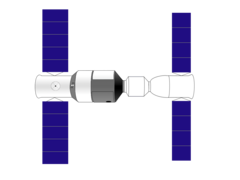Tiangong
Tiangong (Chinese: 天宫; pinyin: Tiāngōng; literally "Heavenly Palace") is a space station program of the People's Republic of China, with the goal of creating a third generation space station, comparable to Mir.
Details
Space laboratory phase
Chinese efforts to develop LEO space station capabilities will begin with a space laboratory phase, with the launch of three Tiangong space modules.[1]
Tiangong 1 "target vehicle"
Template:Main The Chinese docking target consists of a propulsion (resource) module and a pressurized module for experiments, with a docking mechanism at either end. The docking port of the experiment section supports automated docking.[2] Its length is {{safesubst:#invoke:convert|convert}}, diameter is {{safesubst:#invoke:convert|convert}},[1] with a mass of {{safesubst:#invoke:convert|convert}}. Launched on September 29, 2011, it is intended for short stays of a crew of three.
Tiangong 2 "space laboratory"
Template:Main The Chinese Space Lab will be launched in 2013.[1] Configuration is as follows:
- Crew Size: 3, with 20 days of life support resources.[1]
- Length: {{safesubst:#invoke:convert|convert}}[3]
- Maximum Diameter: {{safesubst:#invoke:convert|convert}}[3]
- Mass: {{safesubst:#invoke:convert|convert}}[3]
- Two docking portsTemplate:Citation needed
Tiangong 3 "space station"
Template:Main Template:as of, the Chinese Space Lab is planned to be launched in the 2015 timeframe.[1]
- 40 days of living conditions for three astronauts[1]
- Evaluate regenerative life-support technology, and verify orbital replenishment of propellant and air.[1]

